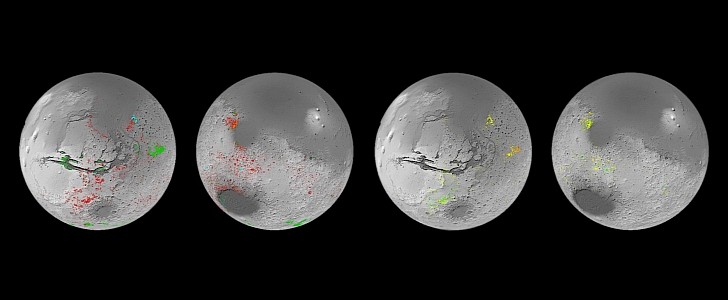We do not exactly have tangible proof Mars once had water (and by tangible we mean a sample to study here on Earth, for instance), but the scientific community is in agreement the life-giving substance was present there at some point. The big question was, how present?
Until recently, humans believed water was once present in liquid form, but in a rather limited fashion, both in extent and duration. A new map of the planet published by the European Space Agency (ESA), though, points to water playing “a huge role in shaping the geology all around the planet.”
The map was created over ten years, using data from the ESA OMEGA (Mars Express Observatoire pour la Mineralogie, l’Eau, les Glaces et l’Activité) and NASA’s CRISM (ars Reconnaissance Orbiter Compact Reconnaissance Imaging Spectrometer for Mars).
It reveals the location and abundances of aqueous minerals, but also clays and salts that could only have resulted from the action of water. And there are hundreds of thousands of such outcrops in the oldest parts of Mars.
“This work has now established that when you are studying the ancient terrains in detail, not seeing these minerals is actually the oddity,” said in a statement John Carter, Institut d’Astrophysique Spatiale (IAS) and Laboratoire d’Astrophysique de Marseille (LAM), Université Paris-Saclay and Aix Marseille Université, France.
As usual when it comes to new discoveries, though, more questions arise from them. This time, the biggest one is whether water was persistent on Mars for long periods or came and went in short but intense intervals.
Soon, Earth will launch a mission to Mars with the goal of bringing back samples for us to study in the confines of our own world. And maybe an answer to said question will come from that.
The research that led to the creation of the new map was published in two separate papers in Icarus and can be studied here and here.
The map was created over ten years, using data from the ESA OMEGA (Mars Express Observatoire pour la Mineralogie, l’Eau, les Glaces et l’Activité) and NASA’s CRISM (ars Reconnaissance Orbiter Compact Reconnaissance Imaging Spectrometer for Mars).
It reveals the location and abundances of aqueous minerals, but also clays and salts that could only have resulted from the action of water. And there are hundreds of thousands of such outcrops in the oldest parts of Mars.
“This work has now established that when you are studying the ancient terrains in detail, not seeing these minerals is actually the oddity,” said in a statement John Carter, Institut d’Astrophysique Spatiale (IAS) and Laboratoire d’Astrophysique de Marseille (LAM), Université Paris-Saclay and Aix Marseille Université, France.
As usual when it comes to new discoveries, though, more questions arise from them. This time, the biggest one is whether water was persistent on Mars for long periods or came and went in short but intense intervals.
Soon, Earth will launch a mission to Mars with the goal of bringing back samples for us to study in the confines of our own world. And maybe an answer to said question will come from that.
The research that led to the creation of the new map was published in two separate papers in Icarus and can be studied here and here.







